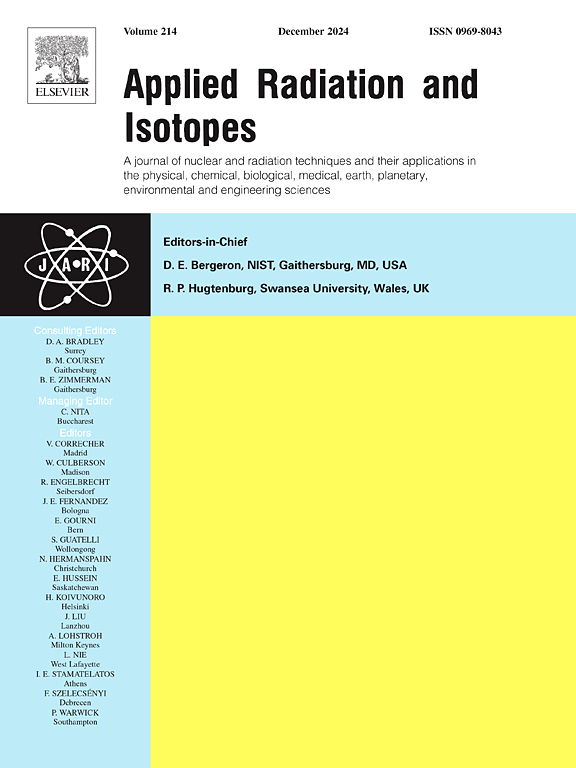Detection of β-ray from 3H with back illuminated sCMOS imager
IF 1.6
3区 工程技术
Q3 CHEMISTRY, INORGANIC & NUCLEAR
引用次数: 0
Abstract
Tritium occurs in nuclear power plants. The energy of beta-rays from tritium is so low that detecting the beta-rays is challenging. Therefore, method of measuring tritium surface contamination is required. Liquid scintillators are generally used to measure the beta-rays. However, this method is complicated to use on-site. To measure tritium surface contamination on-site, we attempted to detect tritium using the GSENSE2020BSI back-illuminated sCMOS imager.
We used a tritium areal radiation source to validate the detection of beta rays from tritium. The beta-rays cause bright spots in images and spread to multipixel. The average number of the pixels by the beta-rays was 4.6 and covered within a 3x3 pixel region. The energy spectrum from 10,000 images with 3x3 binning patterns showed a continuous shape spectrum. The spectra shape was characteristic of beta-ray spectra, demonstrating that the energy spectrum could be obtained with low-energy beta rays from tritium using the back-illuminated sCMOS image sensor. The spectral shape was produced from a radiation simulation using Geant4. From the simulation, the sCMOS sensor was able to measure tritium contamination of 10 becquerels (Bq)/cm2 within 100 s and 4 Bq/cm2 within 480 s.
背照sCMOS成像仪对3H β射线的检测
氚存在于核电站中。氚射线的能量很低,探测到射线是很有挑战性的。因此,需要一种测量氚表面污染的方法。液体闪烁体通常用于测量射线。然而,这种方法在现场使用起来很复杂。为了在现场测量氚表面污染,我们尝试使用GSENSE2020BSI背光sCMOS成像仪检测氚。我们使用氚面辐射源来验证从氚中检测到的射线。射线会在图像中产生亮点,并扩散到多个像素。射线的平均像素数为4.6,覆盖在3x3像素区域内。1万张3 × 3分形图像的能谱显示出连续的形状谱。光谱形状具有β射线谱的特征,表明利用背照式sCMOS图像传感器可以获得氚低能β射线的能谱。光谱形状是通过使用Geant4进行辐射模拟产生的。模拟结果表明,该传感器能够在100秒内测量到10贝克勒尔(Bq)/cm2的氚污染,在480秒内测量到4贝克勒尔/cm2的氚污染。
本文章由计算机程序翻译,如有差异,请以英文原文为准。
求助全文
约1分钟内获得全文
求助全文
来源期刊

Applied Radiation and Isotopes
工程技术-核科学技术
CiteScore
3.00
自引率
12.50%
发文量
406
审稿时长
13.5 months
期刊介绍:
Applied Radiation and Isotopes provides a high quality medium for the publication of substantial, original and scientific and technological papers on the development and peaceful application of nuclear, radiation and radionuclide techniques in chemistry, physics, biochemistry, biology, medicine, security, engineering and in the earth, planetary and environmental sciences, all including dosimetry. Nuclear techniques are defined in the broadest sense and both experimental and theoretical papers are welcome. They include the development and use of α- and β-particles, X-rays and γ-rays, neutrons and other nuclear particles and radiations from all sources, including radionuclides, synchrotron sources, cyclotrons and reactors and from the natural environment.
The journal aims to publish papers with significance to an international audience, containing substantial novelty and scientific impact. The Editors reserve the rights to reject, with or without external review, papers that do not meet these criteria.
Papers dealing with radiation processing, i.e., where radiation is used to bring about a biological, chemical or physical change in a material, should be directed to our sister journal Radiation Physics and Chemistry.
 求助内容:
求助内容: 应助结果提醒方式:
应助结果提醒方式:


